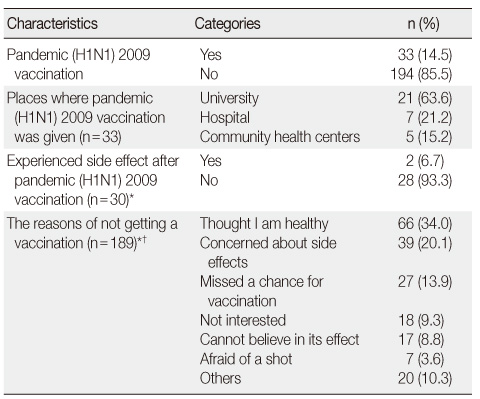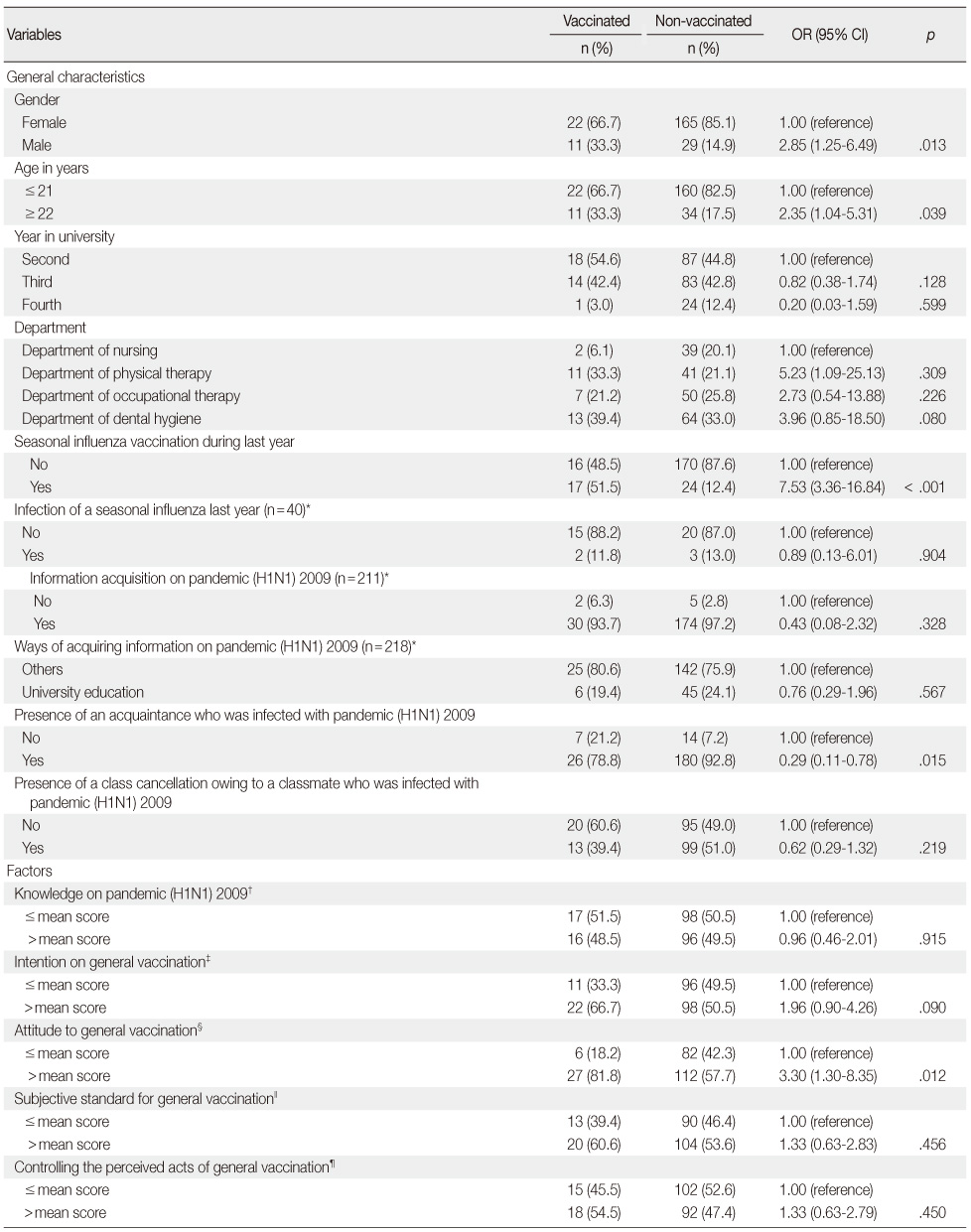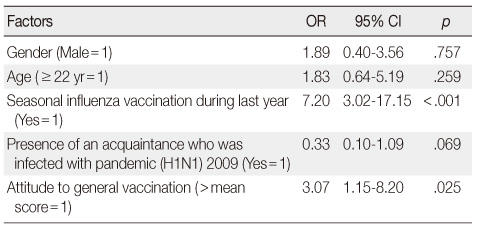Articles
- Page Path
- HOME > J Korean Acad Nurs > Volume 41(3); 2011 > Article
-
Original Article
- Status of and Factors Influencing Vaccination against the Pandemic (H1N1) 2009 Virus among University Students from the Fields of Nursing and Allied Health
- Og Son Kim
-
Journal of Korean Academy of Nursing 2011;41(3):403-410.
DOI: https://doi.org/10.4040/jkan.2011.41.3.403
Published online: June 13, 2011
Assistant Professor, Department of Nursing, Youngdong University, Yeongdong, Korea.
- Address reprint requests to: Kim, Og Son. Department of Nursing, Youngdong University, 12-1 Seolgye-ri, Yeongdong-eup, Yeongdong 370-701, Korea. Tel: +82-43-740-1381, Fax: +82-43-740-1299, oskim-icp@hanmail.net
© 2011 Korean Society of Nursing Science
Abstract
-
Purpose
- This study was to identify the current status of vaccination against the pandemic (H1N1) 2009 virus among university students from the fields of nursing and allied health from a local community and verify factors influencing vaccination.
-
Methods
- The study included 227 students in the fields of nursing and allied health from a provincial university. Data were obtained from these participants between May 31 and June 11, 2010 by using self-report questionnaires.
-
Results
- The rate of vaccination against the pandemic (H1N1) 2009 virus for these participants was 14.5%. No difference was observed in this regard between majors and school year. Factors that influence vaccination against this virus included previous vaccination against seasonal influenza and participants' attitudes toward general vaccination.
-
Conclusion
- The results suggest that for effective pandemic (H1N1) 2009 vaccination of university students from the fields of nursing and allied health, students who have not been vaccinated should be intensively managed. Developing a vaccination program that encourages a positive attitude toward vaccination is recommended.
- 1. Ajzen I, Madden TJ. Prediction of goal-directed behavior: Attitudes, intentions, and perceived behavioral control. Journal of Experimental Social Psychology. 1986;22:453–474. doi:10.1016/0022-1031(86)90045-4.Article
- 2. Butteri MJ, Radu C, Huq F, Wiglesworth A, Durso SC, Bellantoni M. Flu in 15: A novel 15-minute education program to promote acceptance of the influenza vaccine among health care workers. Journal of The American Medical Directors Association. 2010;11:523–527. doi:10.1016/j.jamda.2010.04.001.ArticlePubMed
- 3. Chapman GB, Coups EJ. Time preferences and preventive health behavior: Acceptance of the influenza vaccine. Medical Decision Making. 1999;19:307–314. doi:10.1177/0272989X9901900309.PubMed
- 4. Cheong HJ, Sohn JW, Choi SJ, Eom JS, Woo HJ, Chun BC, et al. Factors influencing decision regarding influenza vaccination: A survey of healthcare workers in one hospital. Infection and Chemotherapy. 2004;36:213–218.
- 5. Choi JS, Choi JS, Park SM. Relationship of nurses' knowledge, attitude and practice in an influenza A (H1N1) base-zone hospital. Journal of Korean Clinical Nursing Research. 2009;15(3):85–94.
- 6. Choi JS, Yang NY. Perceived knowledge, attitude, and compliance with preventive behavior on influenza A (H1N1) by university students. Journal of Korean Academy of Adult Nursing. 2010;22:250–259.
- 7. Chronology of influenza A (H1N1): June 2009. World Health Organization. 2009;06 19 Retrieved December 30, 2009. from http://www.searo.who.int/en/Section10/Section2562_14944.htm.
- 8. Faul F, Erdfelder E, Lang AG, Buchner A. G*Power 3: A flexible statistical power analysis program for the social, behavioral, and biomedical sciences. Behavior Research Methods. 2007;39:175–191. doi:10.3758/BF03193146.ArticlePubMedPDF
- 9. Han SS, Lee JI, Kim YJ. Predicting factors on eating behavior in coronary artery disease patients. Journal of Korean Academy of Nursing. 2007;37:1193–1201.ArticlePubMedPDF
- 10. Iuliano AD, Reed C, Guh A, Desai M, Dee DL, Kutty P, et al. Notes from the field: Outbreak of 2009 pandemic influenza A (H1N1) virus at a large public university in Delaware, April-May 2009. Clinical Infectious Diseases. 2009;49:1811–1820. doi:10.1086/649555.ArticlePubMed
- 11. Jin SM, Lee SG. Vaccination status in school entry aged-children and associated factors on timeliness of vaccinations. Journal of the Korean Society of Maternal and Child Health. 2007;11:44–53.Article
- 12. Jo HS. Factors associated with influenza vaccination behavior among high-risk adults. Journal of Korean Society for Health Education and Promotion. 2002;19:127–138.
- 13. Jung JY, Jung SY, Gwak HS. Prevalence and determinants of influenza vaccination in Koreans. Korean Journal of Clinical Pharmacy. 2005;15:89–93.
- 14. Kang J, Cho J, Kim Y, Kim DH, Lee J, Park HK, et al. Hospital nurses' knowledge and compliance on multidrug-resistant organism infection control guideline. Journal of Korean Academy of Nursing. 2009;39:186–197. doi:10.4040/jkan.2009.39.2.186.ArticlePubMed
- 15. Kee SY. Influenza vaccine coverage rates and perceptions on vaccination in Korea. 2005;Seoul, Korea University. Unpublished master's thesis.
- 16. Kim GH, Lee HY, Cho SI. Knowledge and practice of influenza vaccination among health workers and teachers. Korean Public Health Research. 2004;30:1–12.
- 17. Kim SK. Configuration of a vaccination-behavior model for mothers with infant. 2007;Seoul, Chung-Ang University. Unpublished doctoral dissertation.
- 18. Kim YJ. First death due to 'Influenza A (H1N1) 2009' nosocomial infection. 2009;09 25 The Hankyoreh. 10.
- 19. Korea Centers for Disease Control and Prevention. 2009-2010 influenza A (H1N1) vaccination program in Korea. Public Health Weekly Report. 2010;06;3:357–360.
- 20. Lee DH, Shin SS, Jun BY, Lee JK. National level response to pandemic (H1N1) 2009. Journal of Preventive Medicine and Public Health. 2010;43:99–104. doi:10.3961/jpmph.2010.43.2.99.ArticlePubMed
- 21. Lee JY. Development and evaluation of health program. 2009;Seoul, Gye Chuk Mun Wha Sa Publishing Company.
- 22. Lim J, Eom CS, Kim KH, Kim S, Cho B. Coverage of influenza vaccination among elderly in South Korea: A population based cross sectional analysis of the season 2004-2005. Journal of the Korean Geriatrics Society. 2009;13:215–221. doi:10.4235/jkgs.2009.13.4.215.Article
- 23. Mavros MN, Mitsikostas PK, Kontopidis IG, Moris DN, Dimopoulos G, Falagas ME. H1N1v influenza vaccine in Greek medical students [Electronic version]. European Journal of Public Health. 2010;Retrieved March 18, 2011. 21:329–332. from http://eurpub.oxfordjournals.org/content/early/2010/09/16/eurpub.ckq109. doi:10.1093/eurpub/ckq109.PubMed
- 24. Park GS. The study on the health center avian influenza worker's knowledge, attitude and practical skills about management of avian influenza. 2006;Busan, Inje University. Unpublished master's thesis.
- 25. Wie SH, Kim WJ. Diagnosis and management of novel influenza A (H1N1). Korean Journal of Family Medicine. 2009;30:843–847. doi:10.4082/kjfm.2009.30.11.843.Article
- 26. Yoo S, Jeong H, Park H. The analysis on factors affecting the intention for H1N1 virus vaccination and the impact of negative news report: The comparison between HBM and TPB. The Korean Journal of Advertising and Public Relations. 2010;12:283–319.
- 27. Yoon HS. A survey on the performance of surgical hand scrubs. The Journal of Nurses Academic Society. 1996;26:591–604.ArticlePDF
REFERENCES
Figure & Data
REFERENCES
Citations

- Acceptance of and hesitancy about COVID-19 vaccination among nursing students in clinical practice
Saeryun Kim, Jisuk Lee, Hyunju Yang, Hyunkyun Kim, Marwa Shawky Abdou
PLOS ONE.2023; 18(7): e0286640. CrossRef - Factors associated with Pneumococcal Vaccinations in Older Adults
Ju-Lee Lee, Eun Kyung Lee
Journal of Korean Gerontological Nursing.2018; 20(1): 1. CrossRef - Knowledge and Compliance with Prevention of Respiratory Tract Infection Among Workers in Geriatric Facilities
Og Son Kim
Korean Journal of Nosocomial Infection Control.2015; 20(2): 61. CrossRef - An Integrative Review of Infection Control Research in Korean Nursing Journals
Kyung Mi Kim, Jeong Sil Choi
Asian Nursing Research.2014; 8(2): 128. CrossRef - Current State of Influenza Vaccination and Factors Affecting Vaccination Rate among Pregnant Women
Og Son Kim, Sung Won Yoon
Journal of Korean Academy of Nursing.2014; 44(5): 534. CrossRef
Status of Pandemic (H1N1) 2009 Vaccination among Students in Nursing and Allied Health Fields (N=227)
*Non-respondents were excluded; †Multiple choice item.
Comparison of General Characteristics and Factors of the Pandemic (H1N1) 2009 Vaccinated and Non-vaccinated Groups by Using Simple Logistic Regression (N=227)
*Non-respondents were excluded; †Mean score is 8.03; ‡Mean score is 13.73; §Mean score is 45.76; ∥Mean score is 9.67; ¶Mean score is 15.46.
OR=odds ratio; CI=confidence interval.
Factors Influencing Vaccination against the Pandemic (H1N1) 2009 Virus from Multiple Logistic Regression (N=227)
OR=odds ratio; CI=confidence interval.
*Non-respondents were excluded; †Multiple choice item.
*Non-respondents were excluded; †Mean score is 8.03; ‡Mean score is 13.73; §Mean score is 45.76; ∥Mean score is 9.67; ¶Mean score is 15.46. OR=odds ratio; CI=confidence interval.
OR=odds ratio; CI=confidence interval.
 KSNS
KSNS
 E-SUBMISSION
E-SUBMISSION



 Cite
Cite

